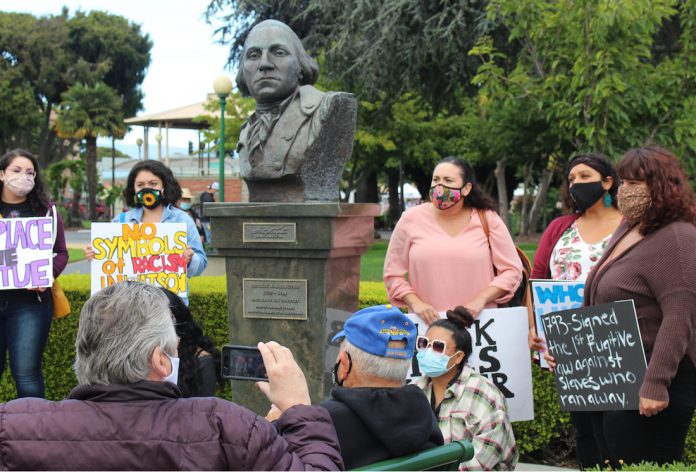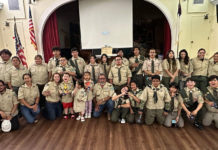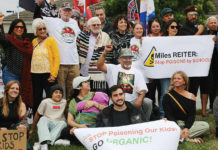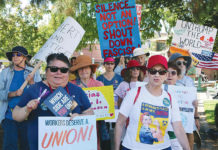
WATSONVILLE—The national debate over monuments of historic figures in public places has reached Watsonville.
A group of local activists has gathered more than 1,100 virtual signatures in support of removing the George Washington bust in the City Plaza. But not all Watsonville residents want the bust removed.
On July 17, Revolunas, the group leading the campaign to remove the bust of the country’s first president from the city’s iconic park, faced pushback from another small group of people that showed up to counter-protest during a planned sit-in around the monument.
The counter-protest group included Alex Solano, a celebrated local veteran and activist who was awarded the Pajaro Valley Chamber of Commerce and Agriculture’s Lifetime Achievement Award in 2018.
“It was just a few of us,” Solano said. “We’re just a bunch of old veterans that are trying to preserve the park—preserve history.”
The sides debated the statue’s relevance as onlookers at Watsonville’s weekly farmers market watched.
“What does this statue symbolize to you?” asked one of the protesters from Revolunas.
“It means freedom,” one of the counter-protesters replied. “Look around… Everyone sitting here… whites, Hispanics… we can all sit here because they are here… in this country.”
The protestor responded: “I understand that. But for me, it symbolizes something completely different.”
The bust won’t be going anywhere for the time being.
Watsonville City Manager Matt Huffaker said the Parks and Recreation Commission will hold a “study session” regarding the bust during its Aug. 3 meeting.
From that session, the city will determine whether “the item comes before the Commission and/or the Council again at some point in the future,” Huffaker said.
Xtlali Cabadas of Revolunas said that the collective is in the process of sending in a formal request to the City to remove the statue. Cabadas said, at the very least, Revolunas wants the community to have a conversation about the bust.
“There’s been a lot of pushback from the community but there also has been a lot of support,” she said. “It deserves a conversation.”
Part of a $100,000 gift from the Alaga Family Estate as a dying wish of Lloyd F. Alaga, the bust has called the City Plaza home since the council approved the gift in 1999. The accompanying plaque on the pedestal reads “George Washington, 1732-1799, Father of His Country” and “First in War, First in Peace, First in the Hearts of His Countrymen.”
For two decades it has sat mostly unnoticed at the park nestled into the center of the city along with a handful of other historic elements such as two cannons, including one that was on the deck of the S.S. Oregon Mail where it was used to fire the first shot celebrating the state of California joining the U.S. in 1850.
But the debate around the bust began as several monuments to presidents, historic figures and the Confederacy across the country have been removed—both voluntarily and not. President Donald Trump issued an executive order calling on state and local officials to protect monuments from forceful removal, deeming such acts a federal offense that could carry a prison sentence of up to 10 years.
There have been no attempts to forcefully remove or permanently deface the bust, but it was covered with Silly String earlier this month.
For some, the bust tells the tale of the so-called founding fathers who united the 13 colonies, led the war for independence from Great Britain and established the frame of government for the U.S. still standing today.
Others, however, say it celebrates a dark time in the country’s history in which Black people were slaves and Indigenous people were slaughtered.
Washington was a prominent slave owner and did little to disband the institution during his time as president or in the years soon thereafter. But five months before his death in 1799, he wrote in his will that his slaves should be freed upon his death.
Cabadas said that aspect of Washington’s legacy is often forgotten and that a real, historically accurate representation of the country’s first president is essential to understanding the complex issues the U.S. is facing today.
“If [the bust] stays up, we at least want a plaque on there that represents who George Washington really was,” she said. “We hope if the city decides to keep that up, the other side of history is told.”











